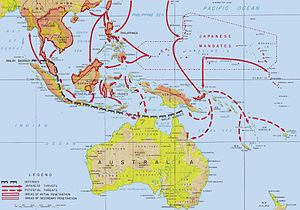
Isoroku Yamamoto was a Marshal Admiral of the Imperial Japanese Navy (IJN) and the commander-in-chief of the Combined Fleet during World War II. Yamamoto held several important posts in the Imperial Navy, and undertook many of its changes and reorganizations, especially its development of naval aviation. He was the commander-in-chief during the early years of the Pacific War and oversaw major engagements including the attack on Pearl Harbor and the Battle of Midway. Yamamoto was killed in April 1943 after American code breakers identified his flight plans, enabling the United States Army Air Forces to shoot down his aircraft.
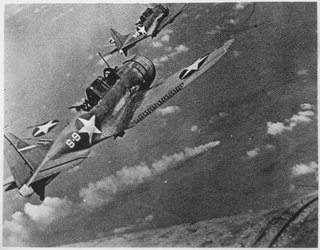
The Battle of Midway was a major naval battle in the Pacific Theater of World War II that took place 4–7 June 1942, six months after Japan's attack on Pearl Harbor and one month after the Battle of the Coral Sea. The U.S. Navy under Admirals Chester W. Nimitz, Frank J. Fletcher, and Raymond A. Spruance defeated an attacking fleet of the Imperial Japanese Navy under Admirals Isoroku Yamamoto, Chūichi Nagumo, and Nobutake Kondō north of Midway Atoll, inflicting devastating damage on the Japanese fleet. Military historian John Keegan called it "the most stunning and decisive blow in the history of naval warfare", while naval historian Craig Symonds called it "one of the most consequential naval engagements in world history, ranking alongside Salamis, Trafalgar, and Tsushima Strait, as both tactically decisive and strategically influential."

The Battle of the Coral Sea, from 4 to 8 May 1942, was a major naval battle between the Imperial Japanese Navy (IJN) and naval and air forces of the United States and Australia. Taking place in the Pacific Theatre of World War II, the battle was the first naval action in which the opposing fleets neither sighted nor fired upon one another, attacking over the horizon from aircraft carriers instead.

Zuikaku was the second and last Shōkaku-class aircraft carrier built for the Imperial Japanese Navy (IJN) shortly before the beginning of the Pacific War. Zuikaku was one of the most capable Japanese aircraft carriers of the entire war.
War Plan Orange is a series of United States Joint Army and Navy Board war plans for dealing with a possible war with Japan during the years between the First and Second World Wars. It failed to foresee the significance of the technological changes to naval warfare, including the submarine, air support and aircraft carriers, and although the Battle of Midway was important, and the US Navy did "island-hop" to regain lost territory, there was no culminating "showdown" battle as anticipated by Plan Orange.
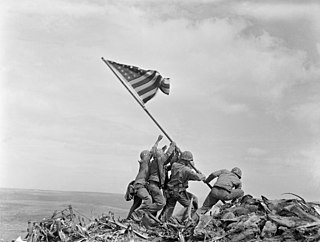
The Pacific War, sometimes called the Asia–Pacific War or the Pacific Theater, was the theater of World War II that was fought in eastern Asia, the Pacific Ocean, the Indian Ocean, and Oceania. It was geographically the largest theater of the war, including the Pacific Ocean theater, the South West Pacific theater, the Second Sino-Japanese War, and the Soviet–Japanese War in the last few months of the war.
This is a list of aviation-related events from 1942:

The Battle of the Coral Sea, a major engagement of the Pacific Theatre of World War II, was fought 4–8 May 1942 in the waters east of New Guinea and south of the Bismarck Islands between elements of the Imperial Japanese Navy and Allied naval and air forces from the United States (U.S.) and Australia.
During World War II, at the beginning of the Pacific War in December 1941, the Imperial Japanese Navy (IJN) was the third most powerful navy in the world, and the naval air service was one of the most potent air forces in the world. During the first six months of the war, the IJN enjoyed spectacular success inflicting heavy defeats on Allied forces, being undefeated in every battle. The attack on Pearl Harbor crippled the battleships of the US Pacific Fleet, while Allied navies were devastated during Japan's conquest of Southeast Asia. Japanese Navy aircraft operating from land bases were also responsible for the sinkings of HMS Prince of Wales and HMS Repulse which was the first time that capital ships were sunk by aerial attack while underway. In April 1942, the Indian Ocean raid drove the Royal Navy from South East Asia. After these successes, the Japanese now concentrated on the elimination and neutralization of strategic points from where the Allies could launch counteroffensives against Japan's conquests. However, at Coral Sea the Japanese were forced to abandon their attempts to isolate Australia while the defeat at Midway saw them forced on the defensive. The campaign in the Solomon Islands, in which the Japanese lost the war of attrition, was the most decisive; they had failed to commit enough forces in sufficient time.

The Solomon Islands campaign was a major campaign of the Pacific War of World War II. The campaign began with Japanese landings and capture of several areas in the British Solomon Islands and Bougainville, in the Territory of New Guinea, during the first six months of 1942. The Japanese occupied these locations and began the construction of several naval and air bases with the goals of protecting the flank of the Japanese offensive in New Guinea, establishing a security barrier for the major Japanese base at Rabaul on New Britain, and providing bases for interdicting supply lines between the Allied powers of the United States and Australia and New Zealand.

Takeo Takagi was an admiral in the Imperial Japanese Navy during World War II. He was the commander of the IJN 6th Fleet, which oversaw the deployment of all submarines.
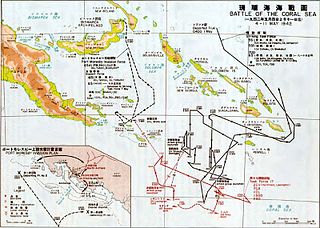
Operation Mo or the Port Moresby Operation was a Japanese plan to take control of the Australian Territory of New Guinea during World War II as well as other locations in the South Pacific. The goal was to isolate Australia and New Zealand from the Allied United States.
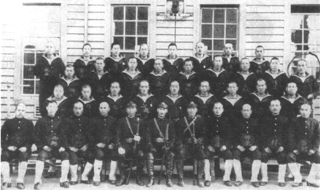
The invasion of Tulagi, on 3–4 May 1942, was part of Operation Mo, the Empire of Japan's strategy in the South Pacific and South West Pacific Area in 1942. The plan called for Imperial Japanese Navy troops to capture Tulagi and nearby islands in the British Solomon Islands Protectorate. The occupation of Tulagi by the Japanese was intended to cover the flank of and provide reconnaissance support for Japanese forces that were advancing on Port Moresby in New Guinea, provide greater defensive depth for the major Japanese base at Rabaul, and serve as a base for Japanese forces to threaten and interdict the supply and communication routes between the United States and Australia and New Zealand.
The two Tone-class cruisers were the last heavy cruisers completed for the Imperial Japanese Navy. The Tone-class cruisers were originally envisaged as the 5th and 6th vessels in the Mogami class. However, by the time construction began, serious weaknesses in the Mogami-class hull design had become clear following the Fourth Fleet incident in 1935. As Japan no longer was obligated to abide by the limitations of the London Naval Treaty, a new design was created and new means of construction were utilized. Although the external dimensions were close to the Mogami class, the design was quite different, with all the main battery of guns placed forward of the bridge, reserving the entire stern area as a large seaplane operations deck. Unlike the U.S. Navy, the Japanese did not have a dual role attack/scout aircraft, nor did they assign any of their carrier aircraft to a reconnaissance role. Little emphasis was placed on this aspect of carrier warfare. Instead the Japanese reserved all of their carrier aircraft for attack roles. Reconnaissance then was relegated to the float planes carried by cruisers. The Tone and the Chikuma were intended to provide the long range reconnaissance needed for Japan's carrier Air Fleets.

Operation RY was the Imperial Japanese plan to invade and occupy Nauru and Ocean islands in the south Pacific during the Pacific conflict of World War II. The operation was originally set to be executed in May 1942 immediately following Operation MO and before Operation MI, which resulted in the Battle of Midway. The primary reason for the operation was to exploit the islands' supplies of phosphate. After a postponement due to interference by enemy forces, the operation was completed in August 1942.

The invasion of Salamaua–Lae, called Operation SR by the Japanese, was an operation by Imperial Japanese forces to occupy the Salamaua–Lae area in the Territory of New Guinea during the Pacific campaign of World War II. The Japanese invaded and occupied the location in order to construct an airfield and establish a base to cover and support the advance of Japanese forces into the eastern New Guinea and Coral Sea areas. As the Japanese arrived, the tiny Australian garrison in the region retreated and did not oppose the invasion.
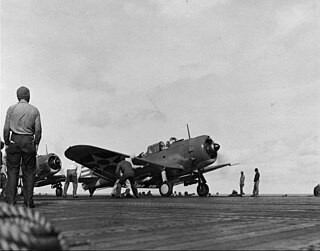
The Marshalls–Gilberts raids were tactical airstrikes and naval artillery attacks by United States Navy aircraft carrier and other warship forces against Imperial Japanese Navy (IJN) garrisons in the Marshall and Gilbert Islands on 1 February 1942. It was the first of six American raids against Japanese-held territories conducted in the first half of 1942 as part of a strategy.
Fleet Radio Units (FRU) were the major centers for Allied cryptological and signals intelligence during the Pacific Campaign of World War II. Initially two FRUs were established in the Pacific, one at Pearl Harbor, Hawaii, called Station HYPO or FRUPAC, and the other, called Station CAST or Belconnen, at Cavite Naval Yard, then Corregidor, Philippines. With the fall of the Philippines to Imperial Japanese forces in April and May 1942, CAST personnel were evacuated to a newly established FRU at Melbourne, Australia, called FRUMEL.
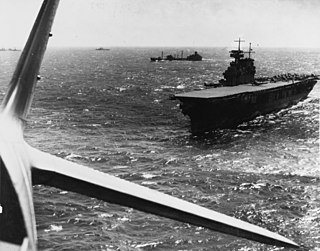
Task Force 17 (TF17) was an aircraft carrier task force of the United States Navy during the Pacific Campaign of World War II. TF17 participated in several major carrier battles in the first year of the war.
Second Operational Phase refers to the invasion strategy detailed in the Greater East Asia War Second Stage Operation Imperial Navy Operation Plan (大東亜戦争第二段作戦帝国海軍作戦計画), presented to the Emperor of Japan, April 1942, by the Imperial General Headquarters. Whereas the objective of the First Phase was to capture resource-rich areas of Southeast Asia needed by the Japanese military, the Imperial Japanese Army, having fully backed the First Operational Phase, was reluctant to assign troops to the Second. The objective of the Second Operational Phase was to threaten the supply line from the United States to Australia by occupying strategic points in eastern New Guinea, New Britain, the Aleutians, Midway, Fiji, and Samoa; occupying these points would also expand Japan's strategic depth. Occupying Hawaii then became a possibility; this, and severance of supply lines between Australia and the United States, offered the hope of early peace negotiations. The territory occupied in the Second Operational Phase could be bartered in exchange for an early end to the war.
